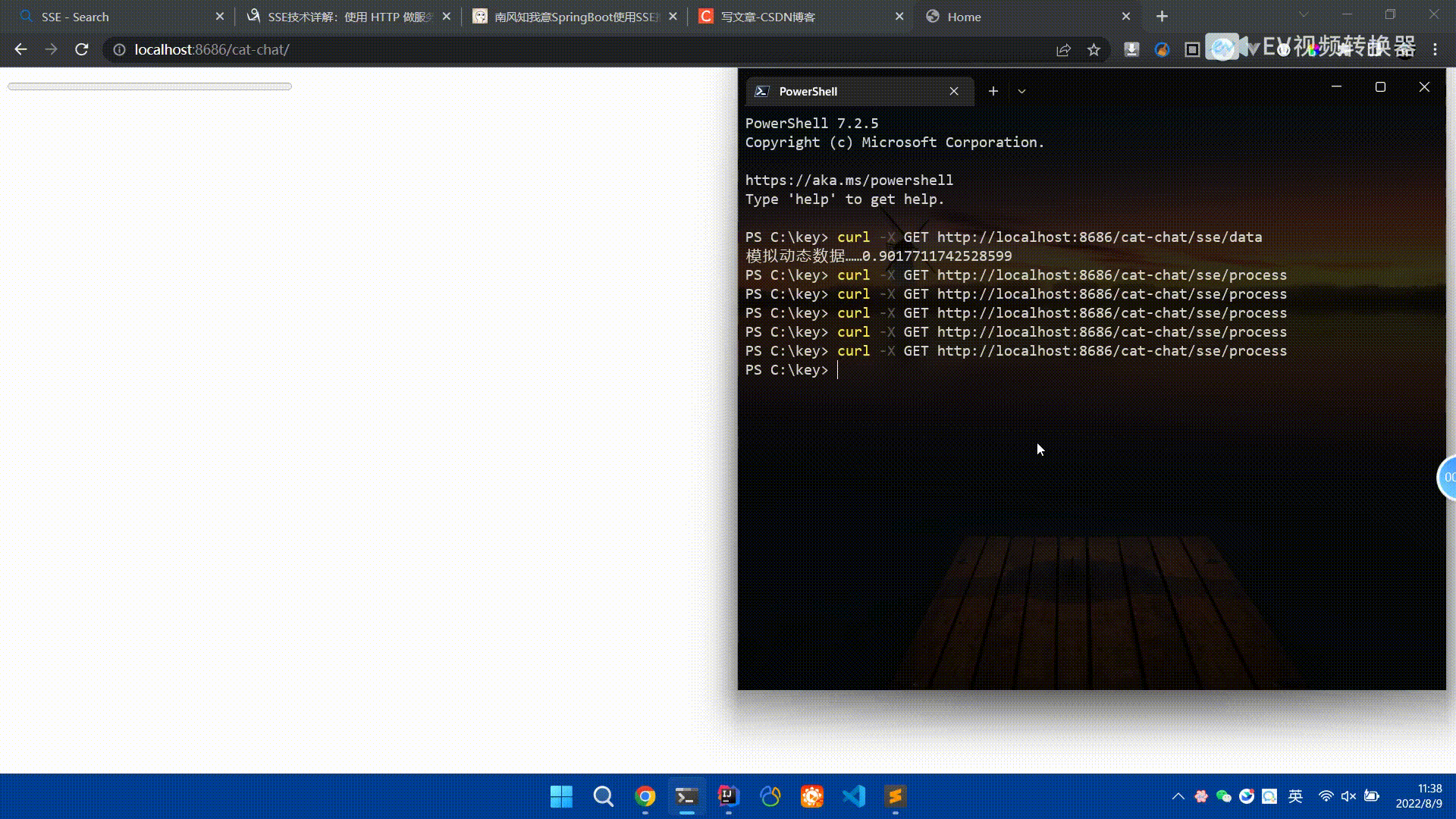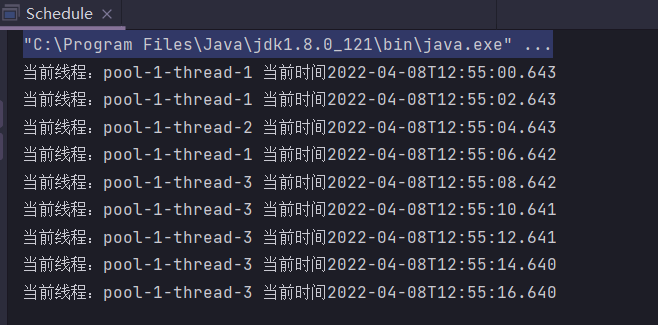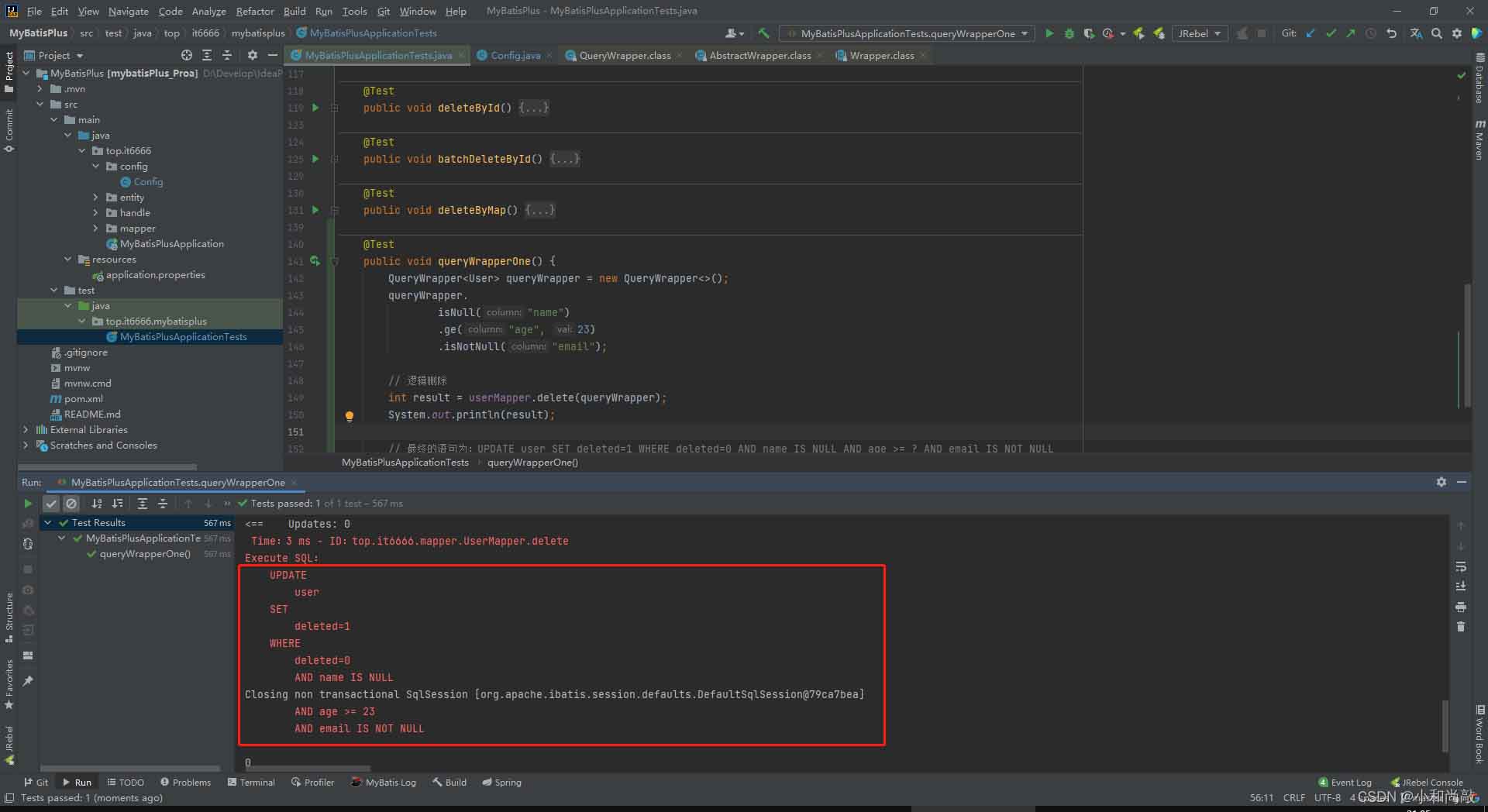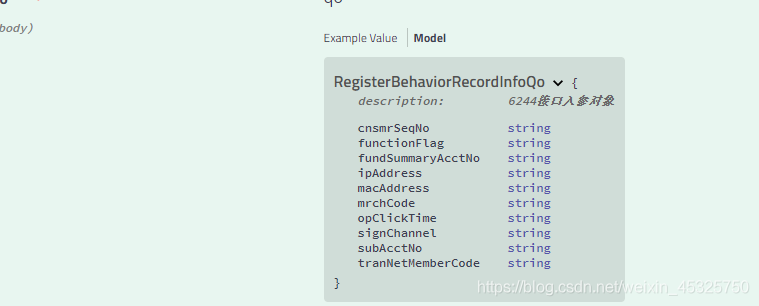这篇文章主要介绍了Spring Boot 使用SSE方式向前端推送数据详解,SSE简单的来说就是服务器主动向前端推送数据的一种技术,它是单向的,也就是说前端是不能向服务器发送数据的
前言
SSE简单的来说就是服务器主动向前端推送数据的一种技术,它是单向的,也就是说前端是不能向服务器发送数据的。SSE适用于消息推送,监控等只需要服务器推送数据的场景中,下面是使用Spring Boot 来实现一个简单的模拟向前端推动进度数据,前端页面接受后展示进度条。
服务端
在Spring Boot中使用时需要注意,最好使用Spring Web 提供的SseEmitter这个类来进行操作,我在刚开始时使用网上说的将Content-Type设置为text-stream这种方式发现每次前端每次都会重新创建接。最后参考该文实现了最终想要的效果:
SSE工具类
SSEServer.java
package vip.huhailong.catchat.sse;
import lombok.extern.slf4j.Slf4j;
import org.springframework.http.MediaType;
import org.springframework.web.servlet.mvc.method.annotation.SseEmitter;
import java.io.IOException;
import java.util.ArrayList;
import java.util.List;
import java.util.Map;
import java.util.Set;
import java.util.concurrent.ConcurrentHashMap;
import java.util.concurrent.atomic.AtomicInteger;
import java.util.function.Consumer;
/**
* @author Huhailong
*/
@Slf4j
public class SSEServer {
/**
* 当前连接数
*/
private static AtomicInteger count = new AtomicInteger(0);
private static Map<String, SseEmitter> sseEmitterMap = new ConcurrentHashMap<>();
public static SseEmitter connect(String userId){
//设置超时时间,0表示不过期,默认是30秒,超过时间未完成会抛出异常
SseEmitter sseEmitter = new SseEmitter(0L);
//注册回调
sseEmitter.onCompletion(completionCallBack(userId));
sseEmitter.onError(errorCallBack(userId));
sseEmitter.onTimeout(timeOutCallBack(userId));
sseEmitterMap.put(userId,sseEmitter);
//数量+1
count.getAndIncrement();
log.info("create new sse connect ,current user:{}",userId);
return sseEmitter;
}
/**
* 给指定用户发消息
*/
public static void sendMessage(String userId, String message){
if(sseEmitterMap.containsKey(userId)){
try{
sseEmitterMap.get(userId).send(message);
}catch (IOException e){
log.error("user id:{}, send message error:{}",userId,e.getMessage());
e.printStackTrace();
}
}
}
/**
* 想多人发送消息,组播
*/
public static void groupSendMessage(String groupId, String message){
if(sseEmitterMap!=null&&!sseEmitterMap.isEmpty()){
sseEmitterMap.forEach((k,v) -> {
try{
if(k.startsWith(groupId)){
v.send(message, MediaType.APPLICATION_JSON);
}
}catch (IOException e){
log.error("user id:{}, send message error:{}",groupId,message);
removeUser(k);
}
});
}
}
public static void batchSendMessage(String message) {
sseEmitterMap.forEach((k,v)->{
try{
v.send(message,MediaType.APPLICATION_JSON);
}catch (IOException e){
log.error("user id:{}, send message error:{}",k,e.getMessage());
removeUser(k);
}
});
}
/**
* 群发消息
*/
public static void batchSendMessage(String message, Set<String> userIds){
userIds.forEach(userId->sendMessage(userId,message));
}
public static void removeUser(String userId){
sseEmitterMap.remove(userId);
//数量-1
count.getAndDecrement();
log.info("remove user id:{}",userId);
}
public static List<String> getIds(){
return new ArrayList<>(sseEmitterMap.keySet());
}
public static int getUserCount(){
return count.intValue();
}
private static Runnable completionCallBack(String userId) {
return () -> {
log.info("结束连接,{}",userId);
removeUser(userId);
};
}
private static Runnable timeOutCallBack(String userId){
return ()->{
log.info("连接超时,{}",userId);
removeUser(userId);
};
}
private static Consumer<Throwable> errorCallBack(String userId){
return throwable -> {
log.error("连接异常,{}",userId);
removeUser(userId);
};
}
}上面这个类可以把它当作一个SSE的工具类,下面我们使用一下它
在Controller层创建 SSEController.java
package vip.huhailong.catchat.controller;
import lombok.extern.slf4j.Slf4j;
import org.springframework.web.bind.annotation.*;
import org.springframework.web.servlet.mvc.method.annotation.SseEmitter;
import vip.huhailong.catchat.sse.SSEServer;
/**
* @author Huhailong
*/
@Slf4j
@RestController
@CrossOrigin
@RequestMapping("/sse")
public class SSEController {
@GetMapping("/connect/{userId}")
public SseEmitter connect(@PathVariable String userId){
return SSEServer.connect(userId);
}
@GetMapping("/process")
public void sendMessage() throws InterruptedException {
for(int i=0; i<=100; i++){
if(i>50&&i<70){
Thread.sleep(500L);
}else{
Thread.sleep(100L);
}
SSEServer.batchSendMessage(String.valueOf(i));
}
}
}上面的connect是用来连接sse的,它返回一个SseEmitter实例,这时候连接就已经创建了,然后下面的process接口是用来推送数据的,我这里是准备让前端实现一个进度条的效果,所以推送的是数字,为了效果明显,我在推送到50到70的时候速度放慢,其余都是100ms
前端代码
<!DOCTYPE html>
<html lang="en">
<head>
<meta charset="UTF-8">
<title>Home</title>
<script>
let data = new EventSource("/cat-chat/sse/connect/huhailong")
data.onmessage = function(event){
console.log("test=>",event)
document.getElementById("result").innerText = event.data+'%';
document.getElementById("my-progress").value = event.data;
}
</script>
</head>
<body>
<div id="result"></div>
<progress style="width: 300px" id="my-progress" value="0" max="100"></progress>
</body>
</html>最终效果:

到此这篇关于Spring Boot 使用 SSE 方式向前端推送数据详解的文章就介绍到这了,更多相关Spring Boot SSE内容请搜索编程学习网以前的文章希望大家以后多多支持编程学习网!
本文标题为:Spring Boot 使用 SSE 方式向前端推送数据详解


基础教程推荐
- 运用El表达式截取字符串/获取list的长度实例 2023-08-01
- springboot下使用shiro自定义filter的个人经验分享 2024-02-27
- 是否适合从javabean类更新数据库? 2023-11-04
- Java中EnvironmentAware 接口的作用 2023-01-23
- JSP 动态树的实现 2023-12-17
- 使用Java和WebSocket实现网页聊天室实例代码 2024-02-25
- JavaWeb 实现验证码功能(demo) 2024-04-14
- Java+mysql实现学籍管理系统 2023-03-16
- Java编写实现窗体程序显示日历 2023-01-02
- 深入理解约瑟夫环的数学优化方法 2024-03-07

















